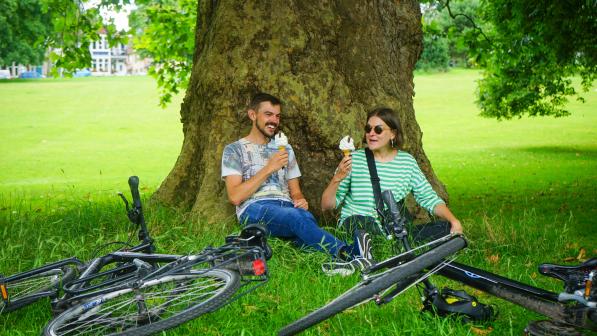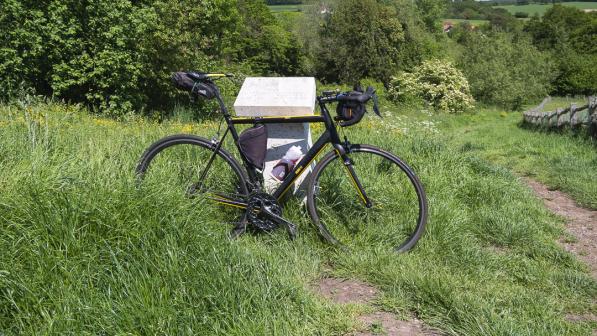How to avoid summer cycling pitfalls

There’s no doubt that summer is the best season for cycling. With long days, warm weather, less rain – although it’s pouring outside as I write this – the temptation is strong to spend all day in the saddle.
However, that doesn’t mean summer cycling is without its own unique challenges. Here we offer some advice on how to avoid the main pitfalls to keep you cycling all through the summer – and beyond.
Sunburn
This is the most common drawbacks of summer cycling. Tan lines are one thing, but angry, red and peeling skin is quite another. It’s not just that it’s painful – we all know the risks of skin cancer.
Use a light, easily absorbed sunscreen. Anything too heavy and greasy will block your pores, preventing you from sweating, as well as mark your clothing. You’ll want one that’s water and sweat resistant, so it doesn’t wash off or drip into your eyes.
Apply it liberally to all exposed areas of skin – not forgetting the ears and back of the neck – before you head out. Don’t miss out any bald spots either. Keep in mind that it doesn’t last forever. You’ll need to reapply throughout your ride.

Clothing is important here too. While your instinct might be to wear as little as possible, thin, sweat-wicking layers will offer more protection. Arm and knee warmers and a sunhat are good ways to cover up.
Some summer cycling kit has mesh panels to help keep you cool. If this is the case, make sure you apply sunscreen under these sections.
Dehydration
Not drinking enough is another common mistake. Dehydration occurs when you lose more fluid than you’re taking in – such as when you’re sweating more during a long bike ride in the sun. It can cause tiredness and loss of energy, while severe cases can lead to fainting or unconsciousness.
It’s easily avoided by drinking sufficient water – a good rule of thumb is to drink 500ml or one bottle every hour. Make sure you have plenty with you and that you can top up along the way. Water mixed with fruit juice and some salt will also help top up essential electrolytes such as sodium, magnesium and potassium.
Hydration starts before you even get on the bike, and you should keep drinking after you’ve finished too.
Heat-related illnesses
There are three of these that are most relevant to cycling in the heat, ranging from uncomfortable to health threatening.
Heat rash
This is a skin irritation caused by excessive sweating during hot and humid weather. It usually affects the areas that sweat most, such as armpits, elbow and knee creases and the back of the neck. It appears as a red rash of pimples or blisters.
Lightweight, sweat-wicking cycling kit is your friend here. If you do develop a heat rash, apply a powder to alleviate symptoms.
Heat exhaustion
If you lose a lot of water and sodium, it can cause heat exhaustion. This can lead to nausea, weakness, dizziness and headaches.
Drink plenty of water, and also make sure you keep energy and nutrient levels up with regular snacks. Keeping your head covered with a light sunhat will also help. If you choose to wear a helmet, make sure it’s well ventilated.
Heatstroke
Also known as sunstroke, this is a severe form of heat exhaustion. It isn’t something that happens regularly, but it’s a good idea to be aware of it. The body’s temperature rises rapidly, the sweating mechanism fails, and the body is unable to cool down. If this happens you should seek medical attention.
If you have a mechanical, move your bike into the shade before you start fixing it. Standing in direct sunlight while concentrating on your bike are ideal conditions for overheating.
Be aware of the symptoms and what to do
It’s a good idea to familiarise yourself with the symptoms of heat exhaustion and heatstroke. These include tiredness, dizziness, headache, feeling or being sick, rapid heartbeat and excessive thirst.
If you experience any of these symptoms, stop cycling immediately, find a shaded area and hydrate. If heat stroke is suspected, seek medical assistance as soon as you can.
More advice and information is available from the NHS.
Protect your eyes
Sunglasses don’t just make you look cool, they protect the health of your eyes too. UV rays can damage your eyes, potentially leading to blindness.

A good pair of sunglasses with full UVA and UVB protection is essential. They’ll also keep dust and debris out of your eyes, which could otherwise lead to injury. A pair designed for cycling is more likely to stay on during the ride. Many have interchangeable or photochromatic lenses, making them more versatile – an important consideration given how expensive they can be.
Overdoing it
It’s so tempting on those long, summer days to spend hours in the saddle and then go back out and do it again the next day. Maybe with a swim or hike in between. You want to make the most of it after all!
It’s easy to overdo things – especially in the heat when your body is working harder to maintain its core temperature. This doesn’t mean you shouldn’t go for long rides – that’s exactly what summer if for! – but make them more leisurely.
Plan in plenty of rest stops – preferably indoors or somewhere shaded. You can use this time to cool down, fuel up and refill your water bottles.
Also make sure you take a couple of rest days every week. And read our advice on staying cool on your summer rides.
Falling foul of the weather
This is the UK. It rains – a lot. The weather is also famously changeable. Your pleasant ride in the sun can quickly become wet, windy and cold.
Always check the weather forecast before heading out and pack accordingly. It’s been said already, but arm and knee warmers really are versatile bits of kit that you can use to cover up in bright sunshine or for a bit of warmth if temperatures drop.
If there’s a chance of rain, take a waterproof. In fact, even if no rain is forecast it’s a good idea to take a waterproof. There are several lightweight option out there that will easily roll up into a jersey pocket or bag.
You might also consider taking a good lock with you. If the weather really turns, you might have shelter inside and you’ll want to secure your bike.
Don’t let the bugs bite
Summer is prime time for midges and other bugs, while if you’re cycling off road ticks can be an issue. In the UK bug bites are likely to be itchily unpleasant rather than dangerous, but Lyme disease – spread to humans from infected ticks – is no fun.
If you’re cycling in shorts in grassy or wooded areas check your legs for ticks and immediately remove any you find. Not all ticks carry the bacteria that causes Lyme disease but it’s best to get rid of them all.

There is some excellent advice on the NHS website. If you suspect you might have Lyme disease see your GP as quickly as possible.
Midge season is the whole of the summer, and some people turn into a moving buffet for these tiny flying menaces. Unfortunately, they’re most active in the mornings and evenings – the cooler times of the day when you’re probably aiming to be out.
The sunglasses you’ve already invested in will help keep them out of your eyes. You should also use a good insect repellent. Apply before you leave the house and then pop it in a bag and reapply regularly.
Flat batteries
It’s easy to forget about lights during the summer – those long days often mean you won’t need them. However, it’s a legal requirement to have front and rear lights if cycling on public roads between sunset and sunrise. It’s also a good idea to have lights on poorly lit trails and paths.
You don’t want to be caught short if there’s any chance that you’ll be cycling in the dark. Any ride might end up being longer than expected due to a long café stop, working late, a couple of mechanicals or just because you got carried away.
It’s too late realising your lights are at home or the battery has gone flat as the sun goes down. Check first. The same goes for your phone. It’s a good idea to ensure the battery is fully charged or you have a portable charger.
Cycling is a safe, fun and often practical activity, whether you’re going on a leisurely club ride or cycling to work. This advice will help make it even more enjoyable!



